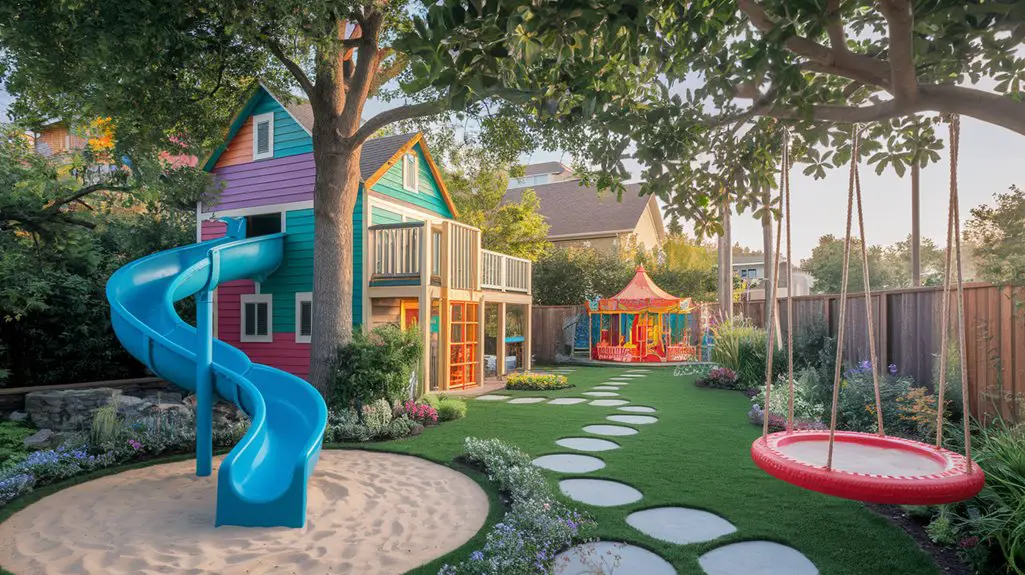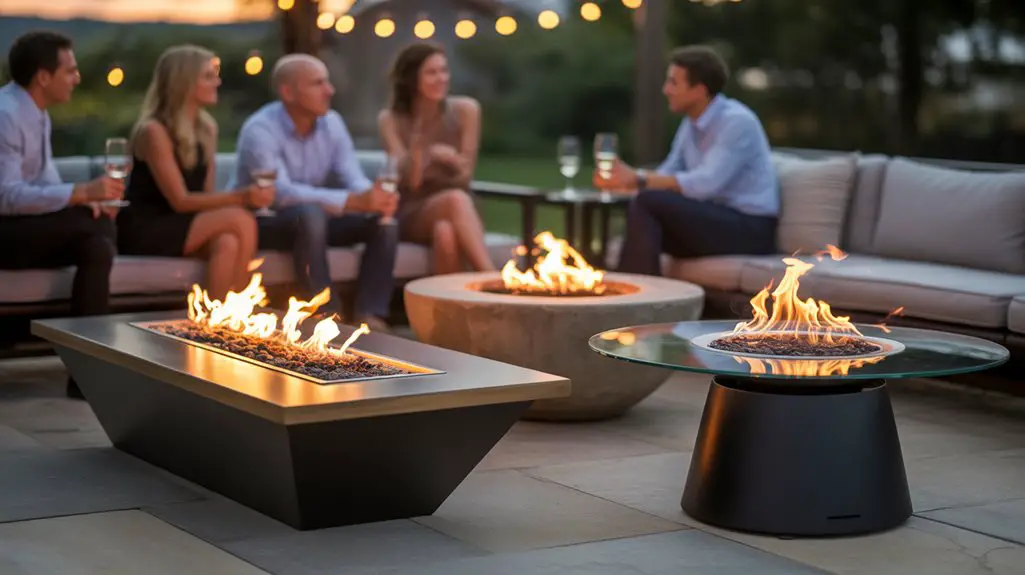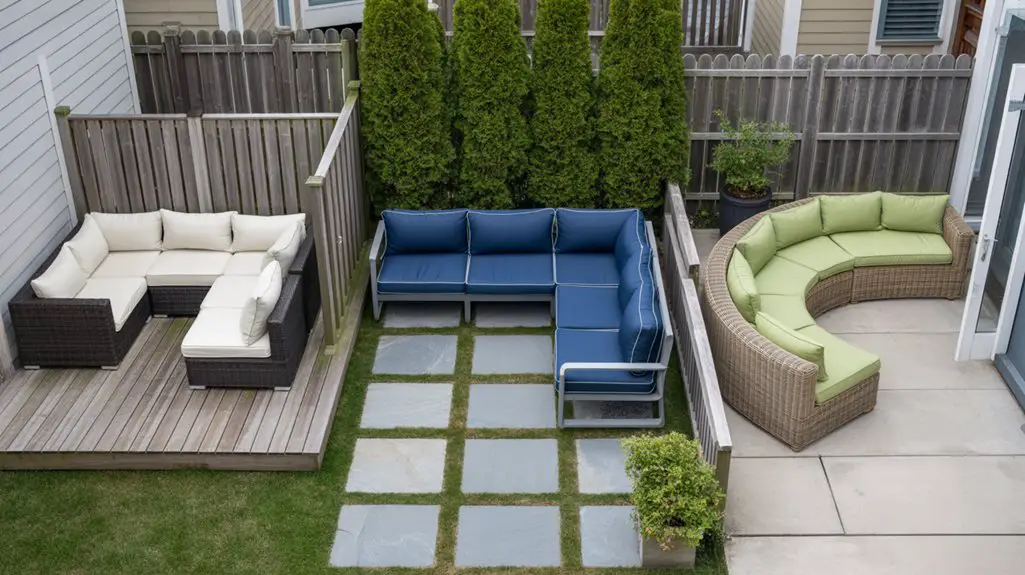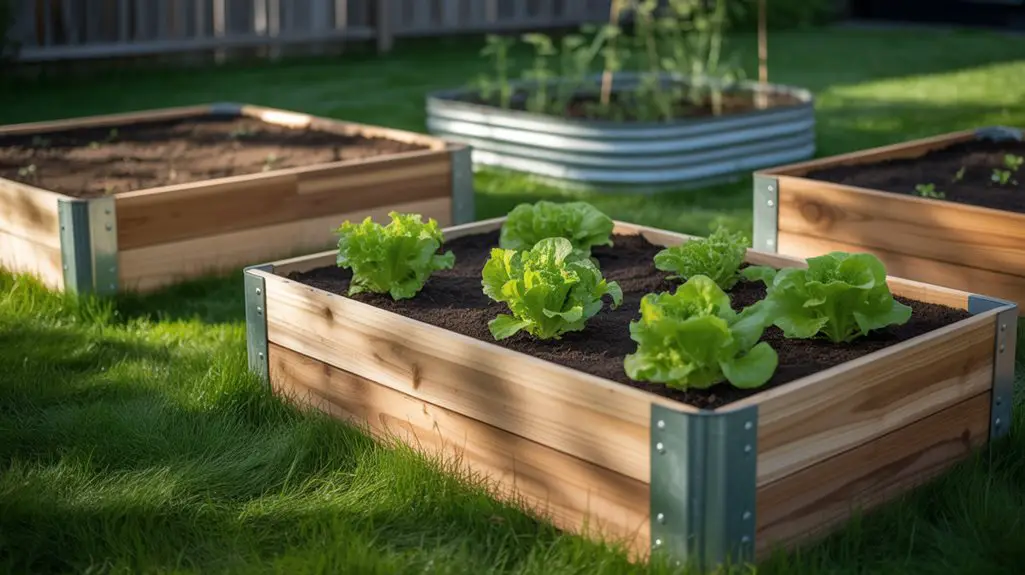Your backyard holds untapped potential for your children’s development. You’ll find that thoughtfully designed play spaces can transform ordinary yards into extraordinary worlds of discovery. Consider how vertical elements create dimension, while natural materials add sensory richness to the landscape. Strategic zones for active play, quiet reflection, and creative expression accommodate different moods and developmental needs. What if your outdoor space could inspire not just play, but genuine wonder in your child’s daily experience?
Natural Play Zones With Tree Stumps and Boulders
When crafting natural play zones, strategically position tree stumps and boulders to create a balanced topography that encourages exploration. Arrange stumps at varying heights (8-24 inches) in circular or serpentine patterns to facilitate jumping sequences and balance practice. Space boulders 18-24 inches apart for safe navigation while maintaining challenge. Incorporate flat-topped stones (minimum 24-inch diameter) as nature tables where children can arrange found objects. Select weathered hardwood stumps with sealed ends to prevent splinters and extend longevity. You’ll want to establish clear sightlines from your home’s windows while designing pockets of discovery just beyond immediate view. For safety, embed all elements 1/3 of their height into compacted gravel bases before topping with engineered wood fiber. This anchoring prevents tipping while allowing for natural drainage. Additionally, consider including elements for exciting backyard games that promote active play and creativity.
DIY Climbing Walls and Adventure Courses
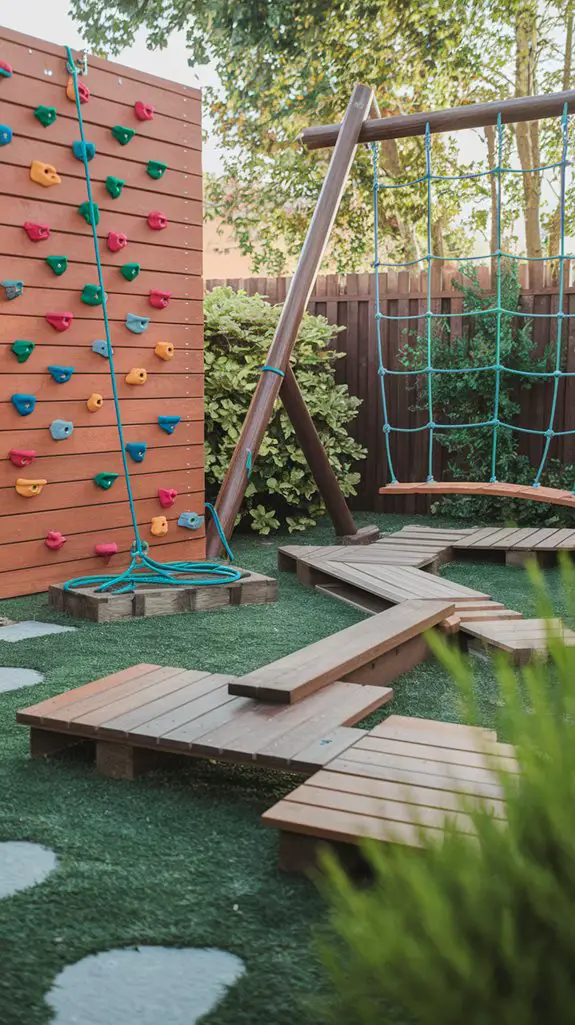
While natural elements provide foundational outdoor play opportunities, vertical challenges offer complementary physical development benefits. Transform your backyard by installing a DIY climbing wall on an existing fence or creating a freestanding structure with varying angles and grip difficulties. Incorporating active kids into your obstacle course design can enhance their enjoyment and physical fitness.
| Component | Materials | Safety Considerations |
|---|---|---|
| Wall Base | Marine plywood (¾”) | Install fall cushioning |
| Handholds | Climbing holds + T-nuts | Secure with lockwashers |
| Course Elements | Weather-treated lumber | 12″ depth wood chips |
Design your adventure course with progressive challenges that connect various play zones. Include cargo nets, balance beams, and hanging obstacles positioned at appropriate heights for your children’s ages. Consider spatial flow when mapping your course—create clear pathways that encourage directional movement while maintaining sightlines for supervision. Weather-proof all components with non-toxic sealants.
Magical Fairy Gardens and Themed Hideaways
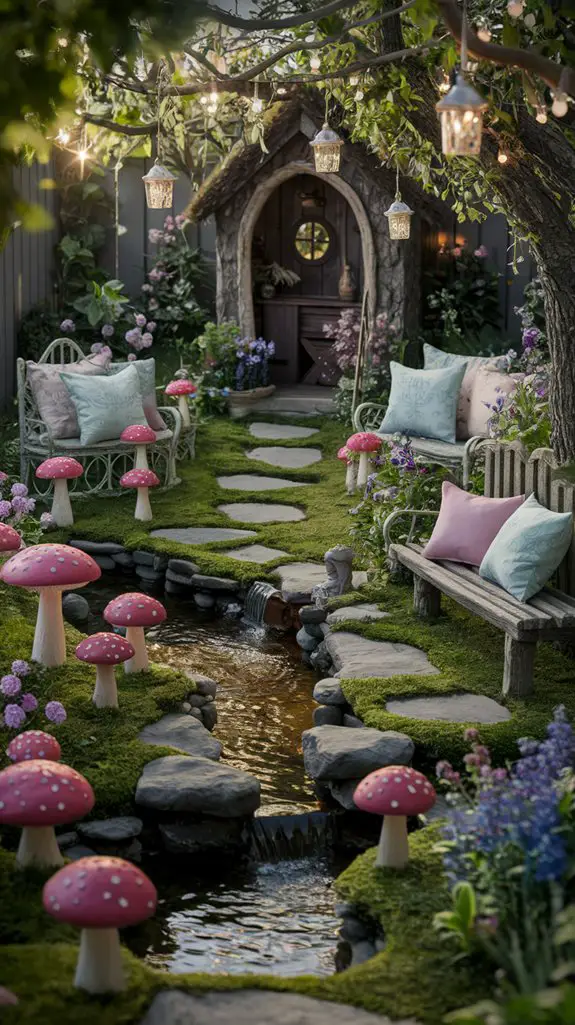
Three key elements transform ordinary backyard spaces into enchanted domains: miniature structures, thoughtful plantings, and child-scaled entry points.
Position tiny cottages beneath low-hanging branches, incorporating moss-covered stones as stepping paths. Select hardy, child-safe plants like lamb’s ear, thyme, and miniature roses to define the boundaries of your magical space.
Create themed hideaways by converting hollow stumps into gnome homes or installing circular hobbit doors into hillsides.
Install low archways (32-36 inches high) wrapped with climbing jasmine or honeysuckle as magical thresholds. Incorporate reflective elements—small mirrors, polished stones, or wind chimes—to catch light and create movement.
Leave deliberate negative space for children to add their own touches, fostering ownership of these pocket-sized worlds where imagination can flourish. Additionally, consider adding backyard playground equipment to encourage active play and enhance the overall experience.
Water Play Features for Hot Summer Days
Safe water elements transform ordinary backyards into summer oases while keeping installation complexity manageable for most homeowners.
Position shallow splash pads on level ground with non-slip surfaces and proper drainage. Install misting stations along playground perimeters, with 4-6 feet clearance from electrical fixtures.
Consider a modular water wall with interchangeable tubes, funnels, and water wheels. Mount components at varied heights (24″-48″) to accommodate different age groups.
For toddlers, implement recirculating stream tables with 3″ depth maximum.
Incorporate rainwater harvesting systems to feed water features sustainably: position collection barrels at downspouts with UV-resistant materials. Rainwater harvesting systems can also help teach children about water conservation in an engaging way.
For all installations, utilize quick-disconnect fittings and shut-off valves to control water flow and facilitate winterization when temperatures drop.
Sensory Gardens With Textured Pathways
Sensory gardens elevate backyard play spaces by engaging multiple senses through carefully orchestrated landscape elements.
Design pathways that shift between contrasting textures—smooth river rocks, rough bark mulch, and springy moss sections create distinctive zones that stimulate tactile exploration while establishing clear navigation patterns.
Position aromatic plants at varying heights to create scent corridors. Lavender, mint, and rosemary release their fragrances when brushed against, rewarding curious fingers with olfactory feedback.
Consider these textural pathway shifts:
- Fine to Coarse – Begin with sand areas shifting to pea gravel, then larger stones
- Soft to Firm – Sequence cork tiles, rubber mulch, and compressed earth
- Smooth to Rough – Arrange polished stepping stones, textured concrete imprints, and natural slate
Incorporating a sensory garden can significantly enhance children’s engagement and discovery in outdoor play spaces.
Custom Playhouses and Treehouses
Custom playhouses and treehouses transform flat play spaces into vertical adventure zones where imagination flourishes in dedicated architectural environments.
When designing these structures, consider your yard’s mature trees or build freestanding platforms secured to pressure-treated posts.
For treehouses, select attachment methods that won’t damage growing trees—specialized brackets and flexible mounting systems accommodate trunk movement while maintaining structural integrity.
Incorporate safety features like 36-inch railings, secure ladders, and non-slip surfaces.
In playhouses, maximize functionality with built-in storage benches, fold-down tables, and weather-resistant materials.
Create multi-level experiences by connecting structures with bridges, slides, or climbing walls.
The most successful designs balance adult safety concerns with children’s desire for semi-private spaces.
Include windows positioned to allow parental supervision while giving children their own domain to rule. Additionally, incorporating endless adventures in these play areas encourages creativity and exploration, enriching children’s playtime experiences.
Artistic Expression Spaces With Outdoor Easels
Transforming a section of your backyard into an artistic sanctuary encourages children to express themselves creatively while connecting with nature.
Position your outdoor easel in a spot with balanced natural light—dappled shade prevents glare while maintaining visibility. Mount weather-resistant acrylic panels or chalkboards at child-appropriate heights to accommodate multiple users simultaneously.
For a complete artistic zone, include:
- A washable surface beneath the easel (try outdoor mats or poured rubber) that defines the creative space while simplifying cleanup.
- Weather-resistant storage cubbies for supplies, with clear containers to showcase colorful materials.
- A dedicated drying area with clotheslines or mesh drying racks mounted at child-height for displaying finished masterpieces.
Add natural elements like stumps for seating and use vertical space for inspiration boards.
Multi-Level Platforms and Secret Tunnels
Multi-level platforms connected by secret tunnels create a dynamic play environment that challenges children’s motor skills while fueling imaginative adventures.
Design your structure with varying heights—12-18 inches for toddlers, up to 4 feet for older children—ensuring each level connects seamlessly through tunnels or bridges. Incorporate flexible corrugated tubing (24-36″ diameter) for crawl-through passages, anchoring them securely between platforms.
Position tunnels at different angles to maximize spatial complexity while maintaining clear sightlines for supervision. Consider integrating translucent materials in tunnel sections to reduce darkness anxiety while preserving the sense of discovery. Creating a Dream Play Space can enhance the overall play experience for children.
Weather-resistant marine-grade plywood with rounded edges works best for platforms, while recycled rubber matting provides essential impact absorption below climbing areas.
Always maintain a fall zone of at least 6 feet around elevated structures.
Sustainable Play Elements From Recycled Materials
Beyond engineered structures, your backyard play area can incorporate eco-friendly elements that teach environmental stewardship while providing rich sensory experiences. Transform discarded items into interactive play features by arranging them strategically throughout your available space.
- Tire Arrangements – Position weatherproofed tires vertically as climbing structures or horizontally as sandpits; interconnect multiple tires at varied heights to create challenging pathways requiring balance and coordination.
- Pallet Construction Zones – Install sanded, sealed wooden pallets as building platforms where children can assemble loose parts; arrange at ergonomic heights for comfortable manipulation of materials.
- Reclaimed Water Features – Repurpose old gutters, pipes, and containers into modular water channels; design with slight gradients (1:20 slope) to create flow dynamics while allowing children to reconfigure the system. Adding stylish outdoor seating can enhance the overall aesthetic of the play area, making it a more inviting space for both play and relaxation.
Conclusion
You’ve now got all the tools to transform your backyard into a child’s paradise. By combining natural elements with thoughtful design, you’re creating spaces that nurture development while sparking joy. Studies show that children who play in varied outdoor environments develop 33% better spatial awareness skills than those in uniform playgrounds. Position your play zones with careful attention to traffic flow, sight lines, and changeover spaces—letting imagination and adventure unfold within a deliberately crafted landscape.

